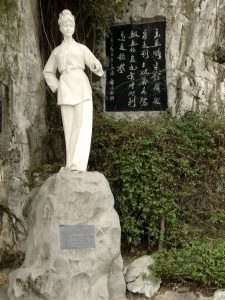Contested Chineseness and Third Sister Liu in Singapore and Hong Kong: Folk Songs, Landscape, and Cold War Politics in Asia
July 12, 2022

On July 12, 1962, Third Sister Liu, a Chinese musical film, was first screened in Singapore. It shattered all box-office records in the country and was continually screened in theatres for more than seven months. Audience members even wrote down the songs one by one and memorized them. Many watched the film more than ten times.
In ‘Contested Chineseness and Third Sister Liu in Singapore and Hong Kong: Folk Songs, Landscape, and Cold War Politics in Asia’, a chapter in The Cold War and Asian Cinemas (2020), Associate Professor Xu Lanjun (NUS Department of Chinese Studies) examines the fever over Third Sister Liu and its relationship with the radical political movements of labourers in Singapore during the 1960s. She focuses on three films: Third Sister Liu, which was shot in mainland China, as well as two of its adaptations from Hong Kong, The Shepherd Girl and The Songfest. By comparing the three films’ usage of folk songs, crowds, love and romance, and landscape, A/P Xu investigates how a sentimental narrative mode like the musical was closely intertwined with local politics of decolonization in Southeast Asia, cultural diplomacy of the People’s Republic of China (PRC), and the cultural connection between Communist China and the diasporic Chinese communities in Cold War Asia.
As a major form of mass culture, cinema has become an important tool to win the hearts and minds of overseas Chinese, especially those in geopolitically significant locations such as Hong Kong and Singapore. The landscape of the remote southwest in China presented in the film relieved the homesickness of many immigrants and created a closer sentimental link with their homeland.
The popularity of Third Sister Liu between 1962 and 1963 paralleled a period in which Singaporeans were debating the issues of merger and independence. In the film, the legend of Third Sister Liu was adapted to “express gender awareness and class struggle”, notes A/P Xu. She argues that a major reason for the popularity of the film in Singapore was that it effectively expressed the public frustrations over social injustices under the British government’s colonial rule. The film was used by different political agents in the independence campaign as it exactly fit the specific moments of conflict and confrontation in Singapore in the 1960s and enjoyed great popularity among the Chinese community. Both the People’s Action Party (PAP) and the Socialist Front held free screenings of Third Sister Liu in order to attract a working class audience. A/P Xu emphasizes that identification with Third Sister Liu by both parties did not entail a preference for the communist PRC, but was aimed at mobilising the mass audience towards greater political activism.
The fever of Third Sister Liu suddenly died out in January 1963, with the end of the conflict between the PAP and the Socialist Front. Despite the official containment of leftist interests after 1960, Third Sister Liu continues to have a following even today.
In contrast to the popularity of Third Sister Liu, the two Hong Kong adaptations The Shepherd Girl (1964) and The Songfest (1963) were not very well-received in Singapore. In fact, many reviews did not even connect the two films with Third Sister Liu as the issue of class struggle, which was the main theme of Third Sister Liu, was virtually absent.
Read the article here.
